1 | The Annunciation
Fra Angelico, Convent of San Marco, Florence
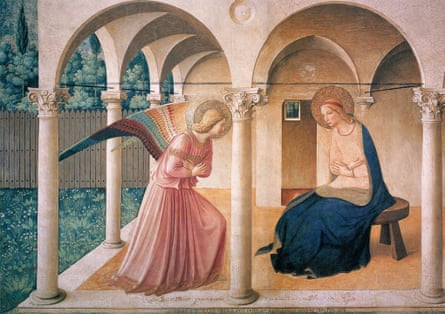
Here is the news, delivered by an angel. The Virgin Mary is pregnant. The son of God is on his way. In this exquisite painting, by a Florentine monk, the split-second of the telling appears to be the very moment of conception itself. Mary listens in astonishment, hands crossed over her body as if receiving a blessing, but also as if protecting the new life there. Her face is a graceful portrait of awe, bewilderment and emotion: the sudden revelation made visible.
2 | The Dream of St Joseph
Philippe de Champaigne, National Gallery, London
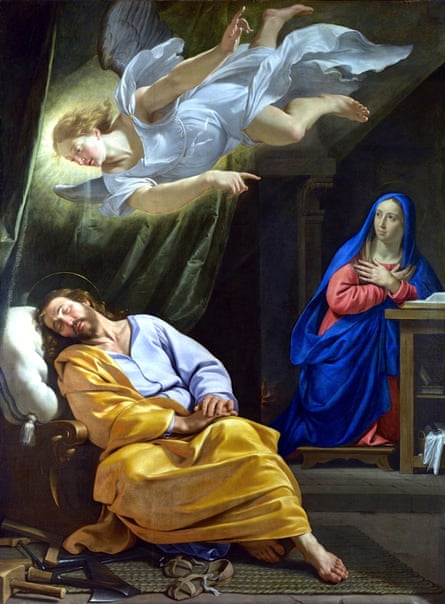
In the Gospel of Matthew, Mary is pledged in marriage to Joseph when he discovers she is pregnant. In consternation, he decides to continue with the marriage but with future divorce in mind. But God sends an angel to Joseph in a dream to explain the divine conception and ask him to name the baby Jesus. The French painter Champaigne is one of very few artists to depict Joseph’s story, imagining his dilemma and this angelic intervention. And just like a figure in a dream, the angel speaks without words, explaining the mystery entirely in sign language.
3 | Mary and Joseph on the Way to Bethlehem (Portinari Altarpiece)
Hugo van der Goes, Uffizi Gallery, Florence
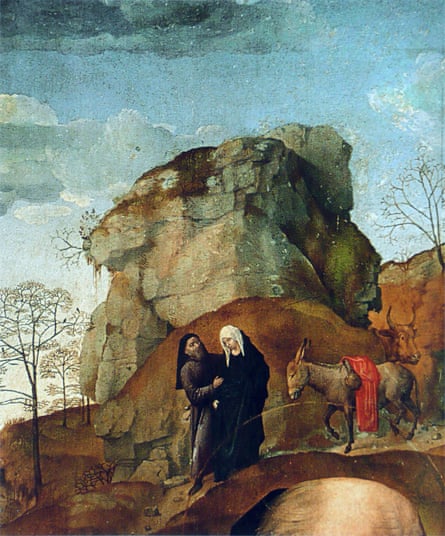
Mary and Joseph are on their way through a rocky landscape. She has climbed down from the donkey, perhaps afraid of riding down such a perilous, ankle-breaking slope. Joseph, grizzled and weary, is helping her along with all his loving kindness, his actions (rather than her physical appearance) suggesting just how pregnant she is. Jesus’s earthly father is generally portrayed as ineffectual but not in this vision, a detail from the famous Portinari Altarpiece in Florence. He is doing everything he can, as husband and prospective new father, to protect his little family from hardship and danger.
4 | The Census at Bethlehem
Peter Bruegel the Elder, Royal Museums of Fine Arts of Belgium, Brussels
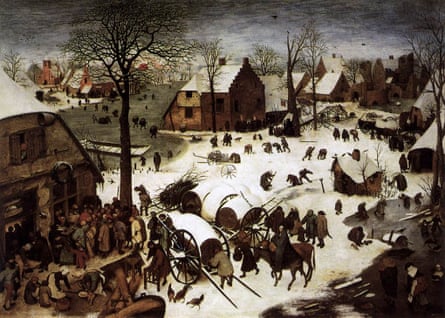
Luke describes the event. “And it came to pass in those days that a decree went out from Caesar Augustus that all the world should be registered… Joseph went to Bethlehem to be registered with Mary, who was with child.” For Bruegel, the event is contemporary, taking place in his native Belgium in the harshest of winters. Mary and Joseph are just two more poor people trudging through the freezing air to queue for this ruthlessly imposed bureaucracy. The only thing that distinguishes them in the general misery and chaos is the proverbial donkey.
5 | The Nativity
Federico Barrocci, Prado museum, Madrid
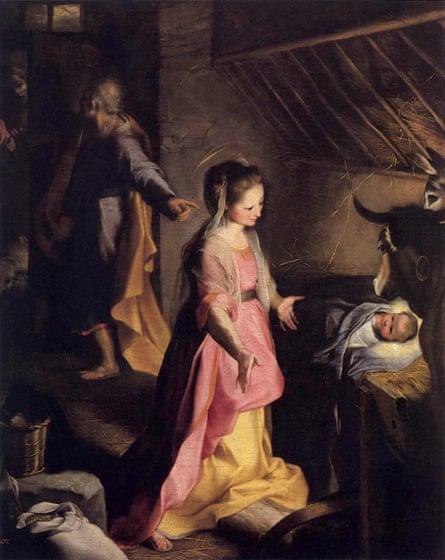
Of all the many thousands of nativity scenes in western art, this one is among the most tenderly maternal. Mary kneels humbly before her God, but she is equally full of love for her newborn baby. Mother and child gaze into each other’s eyes and the whole composition emphasises their mutual bond. The art of Barrocci, until recently one of the most overlooked of Italian masters, was especially popular with women in his lifetime and it is not hard to see why from this nativity, in which the radiant child illuminates the exquisitely loving face of Mary.
6 | Annunciation to the Shepherds
Taddeo Gaddi, church of Santa Croce, Florence
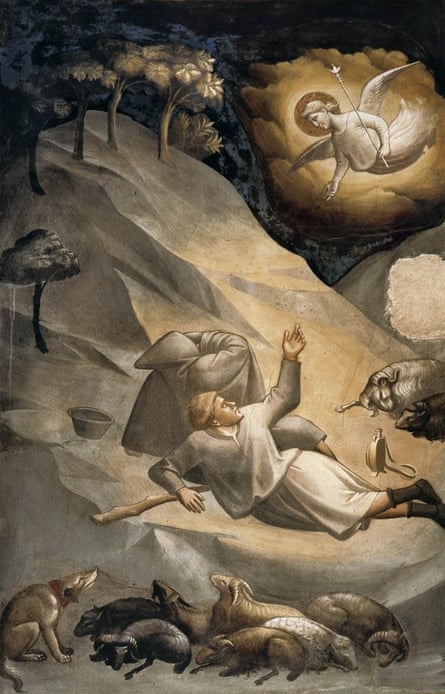
Luke reports that the shepherds were tending their flocks outside Bethlehem when an angel suddenly appeared, announcing that the saviour has just been born in the town. Medieval painter Taddeo Gaddi imagines the scene taking place on a steep hill in the middle of the night. Only one of the shepherds is awake so far, the other hunched like a rock behind him. Sheep and dogs are beginning to stir too, as the angel speaks from above – a shepherd and his flock waking up to the astonishing news.
7 | The Procession of the Magi
Benozo Gozzoli, Medici Riccardi palace, Florence

Not three kings, so much as 33: a whole cavalcade of the great and good (or the rich and powerful) wends its way down a steep valley on the way to Bethlehem. Gozzoli’s fresco, with its deer, hounds and horses, its hunting and social conversation, could almost have been painted from life; and sure enough these Magi include a throng of Medici godfathers and their hangers-on. (The artist himself is among the portraits.) The image commemorates real events – the annual Epiphany procession in 15th-century Florence – as it tries to make biblical events real for contemporary viewers. It’s the high point of the Magi chapel in Florence.
8 | Adoration of the Magi
Botticelli, Uffizi Gallery, Florence

More Medici - including Lorenzo and Giuliano, Botticelli’s patrons – appear in varying states of worship before the newborn Christ. The scene is anything but hallowed and hushed. The Medici are not all intent on the baby, whose miraculous birth has taken place in a derelict outhouse of yawning rafters on the brink of collapse. But Botticelli raises the holy family above these queuing Italians and finds a way to bring the ancient past into the present. He shifts the tense by including himself, on the extreme right, fixing you with a pressuring gaze – how deep is your respect, your love?
9 | The Adoration of the Shepherds
Giorgione, National Gallery of Art, Washington
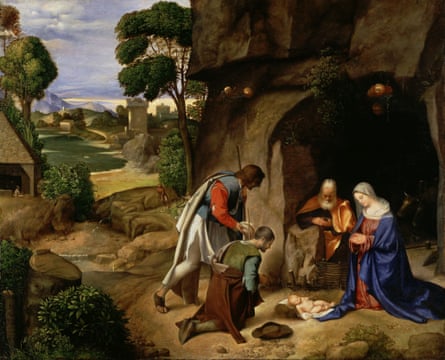
The mysterious Giorgione left very few works at his premature death, but this one is a masterpiece of contemplation. The elderly Joseph is deep in prayer, Mary holds a pose of silent worship before the Christ child, whose hazy face appears so inward-looking. The shepherds, in their ragged clothes, are speechless and spellbound, but full of love for the baby. They are the first to arrive, the first to understand what they are seeing, before the rest of the crowd arrives. The scene is very close and intimate, against the distant Venetian landscape. Not a sheep in sight. By their humility shall you know the shepherds.
10 | Rest on the Flight to Egypt
Orazio Gentileschi, Birmingham Art Gallery
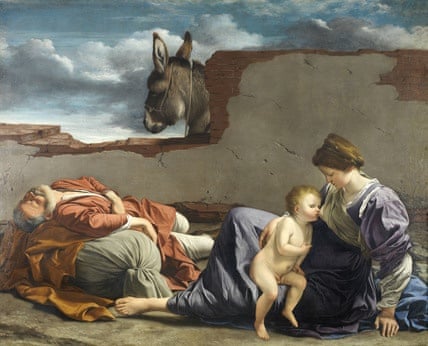
What a scene: bisected by a rough brick wall, dominated by the donkey’s head popping above it, Gentileschi’s Rest is a staggeringly strange composition. Joseph is flat out with exhaustion, his snoring head lolling backwards. The Virgin’s feet are dirty and she is too tired to cradle the hungry baby, who looks furtively in our direction. The holy family are fugitives from murderous Herod and his massacre of the innocents. The nativity scene of a billion Christmas cards is all over now.
Comments (…)
Sign in or create your Guardian account to join the discussion